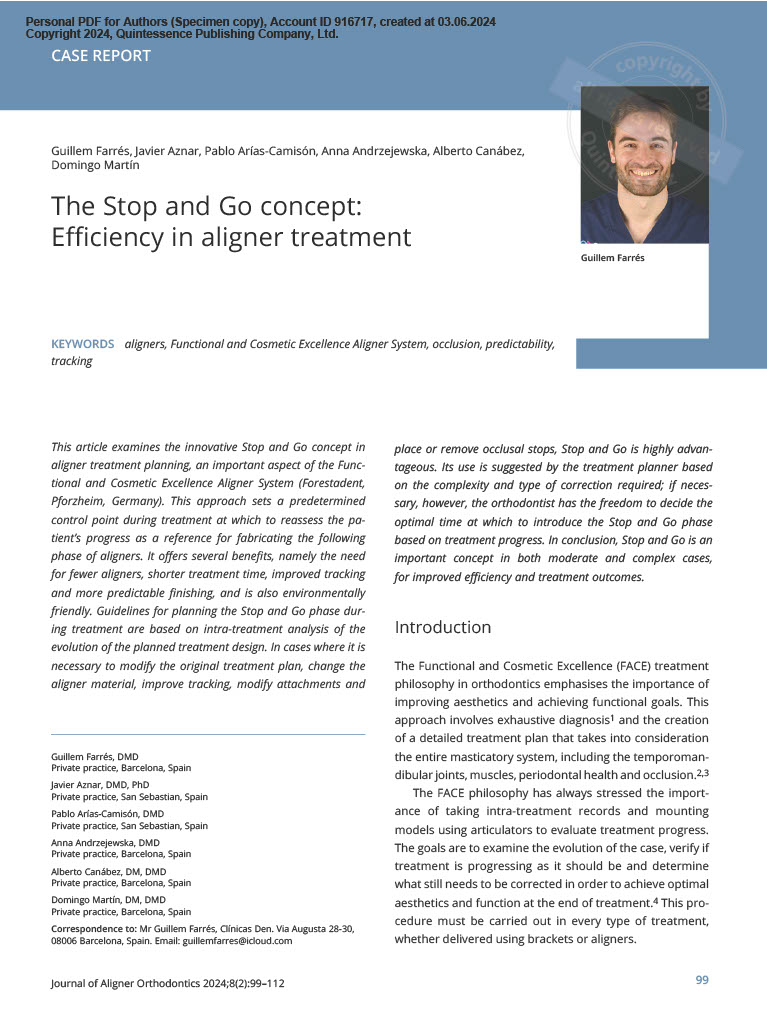Paper language: English

The FAS Aligner System and thetreatment of temporomandibular disorders
AUTHOR: Drs Domingo Martín, Javier Aznar, Guillem Farrés, Pablo Arias-Camisón, Anna Andrzejewska & Alberto Canábez, Spain
English abstract
When there is alteration of any of the internal structures that make up the temporomandibular joint (TMJ), it can be said that we are facing possible temporomandibular disorder (TMD). It should be noted that, according to Wu et al., only 17% of the population is free of TMJ problems, and 83% present with mild to severe manifestations of dysfunction.The literature on the aetiology of TMD describes it as multifactorial, involving biological, environmental, social, emotional and cognitive factors. The relationship between malocclusion and the development of TMD is still a matter of debate. There is currently a great deal of controversy regarding the link between TMD and occlusal factors. Authors such as Serrat, Bottino, Barker, Taboada et al., Cooper and Kleinberg, and Selaimen et al. relate malocclusion to mandibular instability and therefore joint instability. In contrast, authors such as Martínez et al.,13 Kahn et al.,14 Gesch et al.,15 Seligman and Pullinger, and Lipp suggest that occlusal factors do not play an important role in the aetiology of TMD.As the philosopher Karl Popper rightly said, scientific knowledge is the best and most important type of knowledge we have, although it is far from being the only source of knowledge.18 In our daily practice, in addition to considering the scientific literature, we must consider our clinical experience and clinical results. Okeson says, “Although orthodontics cannot be linked to prevention or causing TMD, it is difficult to imagine a specialty that changes interocclusal relationships so much and does not impact masticatory structures and function.All the articles written that do not find a relationship between occlusion and TMD define occlusion from a static point of view.20, 21 Okeson keenly observes this and writes, “The literature finds a minor relationship between occlusal factors and TMD. It should be noted, however, that these studies report on the static relationship of the teeth as well as the contact pattern of the teeth during various eccentric movements. This represents the traditional approach to evaluating occlusion. Perhaps these static relationships can provide only limited insight into the role of occlusion and TMD.”Undoubtedly, if we look at occlusion from a dynamic functional aspect as it relates to joint position, it is likely to provide more information regarding the relative risk of developing TMD. As McKee mentions in a guest editorial in Cranio, “Much of the confusion about occlusion could be resolved if we redefined the definition of ‘occlusion’.” The problem when defining occlusion solely by the position of the teeth is that the mandible is made up not only of teeth at the anterior end but also of condyles and discs at the posterior end. If we redefine occlusion as the position in which the mandible fits into the maxilla, an occlusal analysis would then consist of evaluating not only how the teeth in the mandible fit with the maxillary teeth but also how the unit of the condyle head and articular disc fits into the glenoid fossa. By evaluating occlusion at both the posterior end and the anterior end of the system, it becomes clear that changes at the TMJ level can explain many of the tooth-based malocclusions that have confounded our profession.Condyles become displaced for three main reasons (regardless of trauma): Class II Division 2 molar relationship, fulcrums and progressive condylar resorption.Download paper (PDF)
Access our most valuable content free of charge.
Related Scientific papers

The Stop and Go concept: Efficiency in aligner treatment

FAS® y corticotomías: ortodoncia en el siglo XXI.

FAS® and corticotomies: orthodontics in the 21st century

Modjaw dans la pratique quotidienne de l’orthodontie : regard sur un cas traité avec des gouttières FAS
1st FACE online symposium
The world is changing and in FACE, following tradition, we wont be left behind.
As we all know, we can’t travel or meet, so once again, we will take advantage of technology to turn the situation around.
«Work hard, play hard«
Two days full of experiences, thanks to the participation of 20 different clinics.
We’ll see you on February 26 and 27


